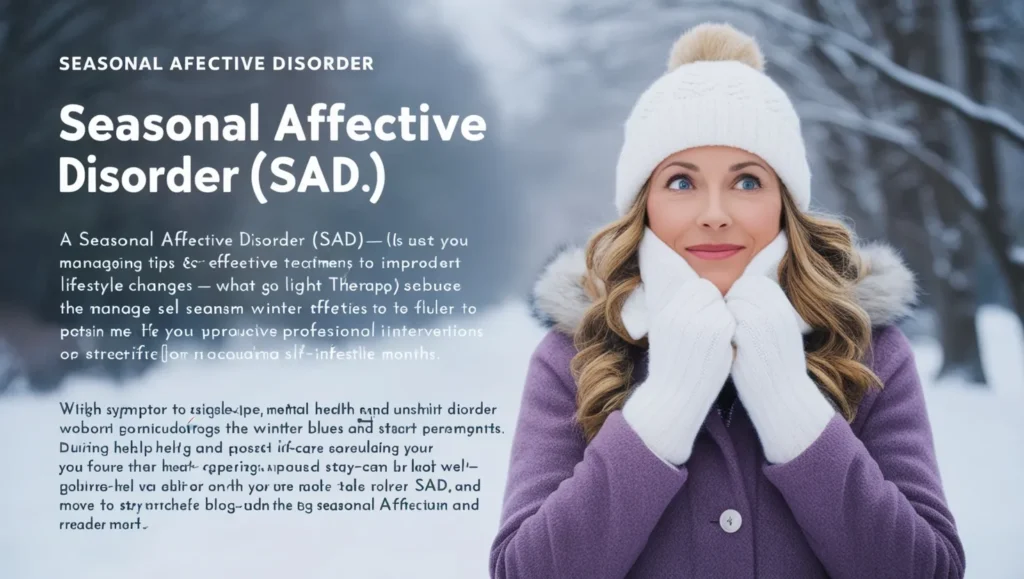Dealing with Seasonal Affective Disorder Tips for Beating the Winter Blues
The arrival of winter often brings shorter days, colder weather, and a yearning for the warmth and light of summer. For many, it’s a time of cozying up with hot drinks and enjoying festive traditions. However, for others, the season comes with an emotional weight often referred to as the “winter blues.” When these feelings become persistent and debilitating, they may point to Seasonal Affective Disorder (SAD).
SAD is a type of depression that typically occurs during the fall and winter months. It’s more than just a fleeting sadness; it can impact sleep, energy levels, mood, and overall well-being. Understanding and addressing SAD is essential for maintaining mental health throughout the colder months. Here’s an in-depth guide on how to manage SAD effectively.
Understanding Seasonal Affective Disorder
SAD is believed to be linked to the reduced exposure to sunlight during winter. This can disrupt your body’s internal clock (circadian rhythm), leading to a drop in serotonin levels and affecting mood regulation. Melatonin production may also increase, making you feel drowsy and less energetic.
Common symptoms of SAD include:
- Persistent low mood.
- Loss of interest in activities once enjoyed.
- Fatigue or low energy levels.
- Changes in sleep patterns (often oversleeping).
- Difficulty concentrating.
- Increased appetite or craving for carbohydrates.
- Feelings of worthlessness or hopelessness.
If these symptoms interfere significantly with your daily life, it’s important to seek professional help.
Practical Tips to Combat SAD
While professional therapy and medication may be necessary for severe cases, there are several strategies you can adopt to ease the symptoms of SAD. Here are some tried-and-true tips:
1. Maximize Exposure to Natural Light
- Get Outside: Spend as much time as possible outdoors during daylight hours. Even a short walk can make a big difference.
- Let the Light In: Open curtains wide, trim any obstructions outside your windows, and sit near natural light sources when indoors.
- Sunlight Simulators: Consider investing in light therapy lamps, which mimic natural sunlight and help regulate your body’s internal clock.
2. Maintain a Consistent Routine
- Regular Sleep Schedule: Going to bed and waking up at the same time every day can stabilize your circadian rhythm.
- Balanced Eating: Avoid overindulging in carbs and sugary treats. Opt for a diet rich in lean proteins, whole grains, and colorful vegetables.
- Stay Active: Regular exercise boosts endorphins and serotonin, improving mood and energy levels.
3. Engage in Activities That Spark Joy
- Pursue hobbies that make you feel fulfilled, whether it’s reading, painting, or cooking.
- Socialize with friends and family to stay connected and combat feelings of isolation.
- Practice mindfulness or meditation to cultivate a sense of calm and focus.
4. Try Light Therapy
- Light therapy, or phototherapy, involves sitting in front of a specialized light box for about 20–30 minutes daily. This is one of the most effective treatments for SAD.
- Consult a healthcare provider to determine the right type and duration of light therapy for your needs.
5. Seek Professional Help
- If your symptoms are severe, a mental health professional can recommend:
- Talk Therapy (Cognitive Behavioral Therapy): CBT can help you reframe negative thoughts and establish healthier coping mechanisms.
- Medication: Antidepressants might be prescribed to regulate serotonin levels.
6. Practice Self-Care
- Prioritize Relaxation: Engage in activities like yoga, stretching, or taking warm baths to ease stress.
- Limit Alcohol and Caffeine: These substances can interfere with sleep and exacerbate mood swings.
- Gratitude Journaling: Reflect on things you’re grateful for to shift focus from challenges to positives.
Final Thoughts
SAD doesn’t have to dominate your winter. By staying proactive, you can create an environment that supports mental and emotional well-being. Small lifestyle adjustments, combined with professional guidance when necessary, can help you thrive even in the darker months.
Remember, it’s okay to ask for help. SAD is a recognized and treatable condition. With the right strategies and support, you can enjoy a more balanced and fulfilling winter season.

